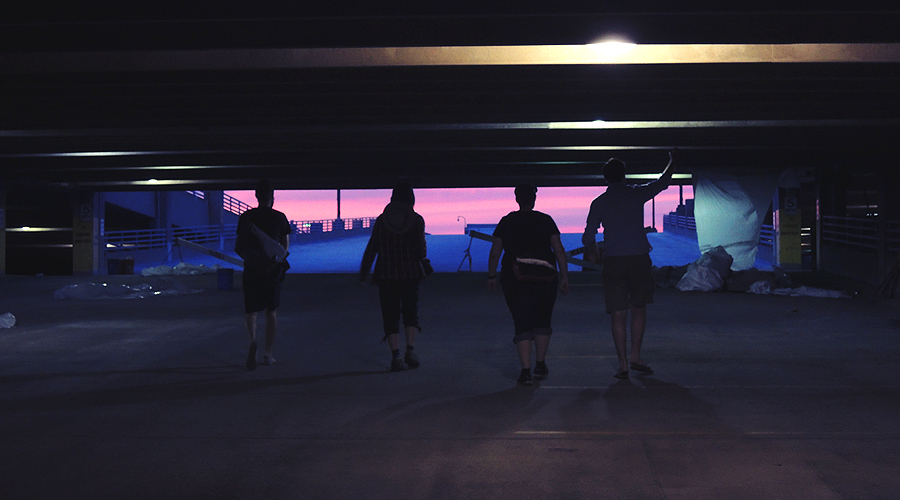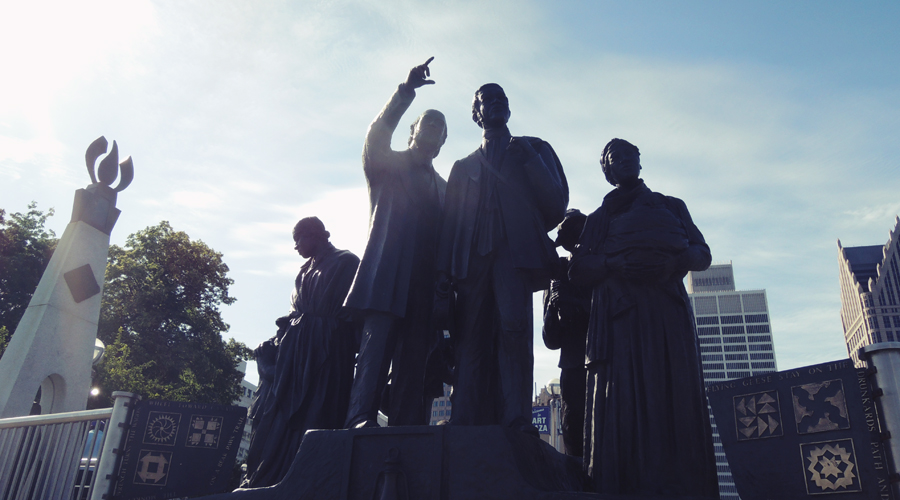
Toronto (+1 Montreal, +1 NYC via Tennessee) AMC crew returning to the Wayne State parking lot
Last weekend I attended my first ever Allied Media Conference in Detroit, Michigan. I was deeply inspired (and a little overwhelmed) by both the conference and the city itself, and hope to be back for the next edition. The AMC brings together thousands of participants engaged in media activism, a large percentage of whom also present sessions and workshops, and truly is a network of networks. It being my first conference, I don’t feel like I’m well positioned to attempt to describe it, in all its diversity and complexity, but I thought I would share some notes all the same, to document and provide touch points moving forward back in Montreal.
The Sessions
I participated in fewer sessions than I intended to, the pace was far faster than I had imagined, and I often felt I needed a break to absorb and reflect afterwards, rather than rush to the next one. I spent a lot of time hanging out in the Future Design Lab practice space, or wandering the Wayne State grounds, chatting with people and sharing stories. As the weekend progressed, the Future Design lab filled with images and texts, mind maps and posters (and wormholes!), it was a beautiful thing to observe this rich accretion of ideas.
The sessions I did attend included What is the Future of Design for Social Justice?, Activist Editing for Movement Publishing, Building The Other World That’s Possible, Co-Designing Our Cities, Creative Resistance and Direct Action, What is “Place-keeping”?, and Gentrification is Not Inevitable. I particularly appreciated the Creative Resistance session, facilitated by Oakland’s Design Action Collective, as we tackled real issues that were brought to the table by session members with an amazing social justice brief model. Our group addressed the displacement of homeless in Baltimore via the fencing off of a public memorial site. The dynamic of our makeshift group was infectious, and within the hour and a half session, we had the solid foundations of a really well-rounded campaign, despite a mansplaining incident that was quickly, efficiently and positively nipped in the bud. I’m hoping (and hopeful) that this campaign will actually be implemented, and look forward to hearing back from our Baltimore representative. Co-Designing our Cities, facilitated by new Toronto-design-friend Jay Wall, was a fun and thought-provoking experience in urban planning, where participants acted out assigned stakeholder roles (resident, developer, city councillor, architect, etc.) to address a fictive/real gentrification proposal. Of course, I picked up the role of “the activist”…
The thread that ran through all these diverse sessions, and the AMC as a whole, is a baseline anti-oppression and anti-authoritarian framework that leads to really fluid participatory modes of learning and making. The approach in each session was markedly different; using role-playing, structured activities, skill-sharing, storytelling, or facilitated discussions, yet the intrinsic framework makes all these approaches… approachable, in the best sense of the word. The organisation of the conference itself works in a similarly non-hierarchical fashion, a truly anarchist model throughout, though strangely, it was a term I rarely heard used there. Whether this is because anarchism is intrinsically self-understood by those in attendance, or the opposite; that the term anarchism isn’t applied in the same way within these diverse communities, I couldn’t quite figure out.

In the lobby of the Wayne State Tower Dorms, “cartographic typography.”
Designing Cultures of Resistance
Given the incredible participatory approaches within the sessions I attended, my caucus felt more like a presentation, which I felt a bit bad about. Furthermore, I proposed a reversal (not necessarily a contradiction) on a lot of the focus throughout the conference on design as process, and looked more to the materiality of design objects as a starting point of analysis for the construction of the social relations produced through design. It almost felt a bit subversive… Nonetheless, there was a healthy discussion, which at times veered into strange places (an argument about the origins of Helvetica at a social justice conference?), and I received some really great feedback from various attendees I ran into throughout the weekend. I felt the presentation was really appreciated, and I was happy to shed some light on the Quebec student strike to fellow activists, and also discuss issues of precarity and labour within our movements. I’ve certainly been inspired to continue building on and refining these ideas over the next few months.

“CARE”
Creative Place Keeping
One of the things that amazed me throughout the conference, was how similar yet different issues could be between cities in the US and in Canada, and how those nuances could create different languages/expressions. “Creative Place Making” being a term I had never encountered before, but seems extremely popular within the US. From my brief exposure to the idea, it seems like a counter-understanding of Richard Florida’s awful “rise of the creative class” gentrification arguments. Within this context, the idea of Place-Keeping becomes very interesting and powerful, and seems to be a great starting point to deal with the complexities of issues around gentrification that I am often thinking about in Montreal. It was great to hear from Roberto Bedoya, who sits on both sides of the fence as an activist and public policy representative.
Science Fiction and Prefigurative Politics
The AMC started as a zine-fair, and zines emerged out of science-fiction. It only seems natural then (if one does a bit of a a mind-bending exercise) that science-fiction acts almost as a political backbone to the conference. Octavia Butler is a hero amongst heroes, and her brood had a significant place within the conference. To be honest, I had never given much thought to science-fiction beyond entertainment, but with a bit of prodding, it makes a lot of sense. Especially coming from marginalised peoples, indigenous, QTPOC, etc. simply projecting the existence of your communities into the future is an incredibly political act.
Detroit itself felt a bit like science fiction to me, coming from the sheltered cities of Montreal and Toronto, it’s landscape seemed post-apocalyptic. The empty 6 lane highways, vacant crumbling buildings and infrastructure, small groups gathered around a preacher on the downtown streets. While we were there, community activists were working to prevent the city from cutting off almost 300,000 people from running water, or to at least mitigate the disaster. I hardly feel well placed to write about this, as I only saw very little of the city, for a very short period of time. I eventually stopped myself from taking pictures of hollowed out buildings, as it didn’t feel like the images I wanted to share. But yeah, Detroit felt a bit like the future of capitalism, it’s logical conclusion, except, of course, that it’s far from over.

The blackletter “D” logo of the Detroit Tigers was visible everywhere, and read as a unifying symbol of civic pride. The tigers themselves at Comerica Park were pretty impressive.
In contrast to the landscape (which I have to admit, was strikingly beautiful in its abandon), the people were uniformly lovely, friendly and welcoming. In the areas where there was vitality, it was incredibly vibrant. From the white-clad woman singing the blues at the Eastern Market, to the people we met on the street that we couldn’t leave without hugs and sincere proclamations of peace and love. On the waterfront, impressive sculptural tributes to the labour movement and the underground railroad speak clearly to the city’s social history. As we left downtown, under the proverbial shadows of the GM Renaissance towers, a brass band played raucously—and within the rhythmic horn blasts, it was impossible to not hear the urgent undertones of collective defiance.

Gateway to Freedom.
Many thanks to Una Lee for inviting me to participate in the AMC, to Patricio Davila for bringing me back to Toronto, and to everyone I met in Detroit; Majestic and Knowledge from NYC, Amir from One Love (best joke ever), Lillian from Cred Philly, Danielle from the Peak, Victoria from OPIRG York, Shelby, Sun, and so many others, I’ll see y’all again soon.
No Comments so far
Leave a comment
Leave a comment














